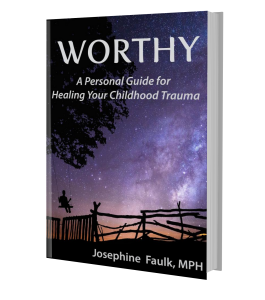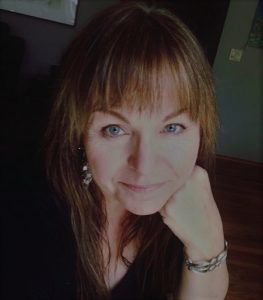Borderline Personality Disorder: The Catch-all Diagnosis
 This is the third post in a series addressing the misdiagnosis of Post Childhood Trauma Symptoms in Adulthood:
This is the third post in a series addressing the misdiagnosis of Post Childhood Trauma Symptoms in Adulthood:
According to the National Alliance on Mental Illness (NAMI) borderline personality disorder (BPD) cannot be diagnosed with any medical test, its origin is unknown, no neuroimaging techniques indicate the presence of BPD and no gene is indicative of BPD. They vaguely allude that oxytocin and serotonin may possibly have something to do with BPD, but do not say in what way. Very mysterious definition considering they claim that 1 in 20 Americans have BPD which has a pervasively negative effect throughout nearly every facet of their life. Any and all the healing steps in Part II of my book WORTHY: A Personal Guide For Healing Your Childhood Trauma, can bring noticeable improvement; particularly supplementing with amino acids, practicing meditation and the breathing exercises. Those with a history of childhood trauma are believed to be especially at risk, as are those with a first-degree relative who has a mental illness.
The following symptoms for BPD are taken directly from the official NAMI website:
- Marked mood swings with periods of intense depressed mood, irritability and/or anxiety lasting a few hours to a few days (but not in the context of a full-blown episode of major depressive disorder or bipolar disorder).
- Inappropriate, intense or uncontrollable anger.
- Impulsive behaviors that result in adverse outcomes and psychological distress, such as excessive spending, sexual encounters, substance use, shoplifting, reckless driving or binge eating.
- Recurring suicidal threats or non-suicidal self-injurious behavior, such as cutting or burning one’s self.
- Unstable, intense personal relationships, sometimes alternating between “all good,” idealization, and “all bad,” devaluation.
- Persistent uncertainty about self-image, long-term goals, friendships and values.
- Chronic boredom or feelings of emptiness.
- Frantic efforts to avoid abandonment.
Most of these symptoms sound like a description of the emotional roller coaster of being a teenager. In other words, I believe most of these behaviors are being expressed by younger (much earlier) parts of adults that did not have the opportunity to integrate into their adult self due to childhood trauma which has yet to be resolved. Those struggling with post childhood trauma symptoms in adulthood appear to share some of the symptoms applied to borderline personality disorder. You may notice some similarities from the ADHD/ADD descriptions (an earlier post you can find here). Following are my descriptions of what is, in truth, occurring for patients who have post childhood trauma symptoms in adulthood and have mistakenly been diagnosed with Borderline Personality Disorder.
- Symptoms of marked mood swings. As children and/or teenagers they experienced trauma with no emotionally healthy adult to help them process through it. Since they did not have the capacity to process it theirself, they suppressed their confusing, painful, emotional response to it. As adults the resulting unresolved confusion, fear, shame and grief are still alive and unwell within their mind and body. These feelings often move within them like waves and they usually are unaware of what precipitates such mood swings. Quite often it is something that touches a grieving part of them. It is this grieving part that lashes out in pain.
- Symptoms of intense anger. Those with post childhood trauma symptoms in adulthood are easily triggered. To others their reactions appear excessive. They do not understand that whatever it is that triggered a person with a history of chronic childhood trauma it has tapped into a suppressed, traumatized part of theirself. When this happens they are not only reacting to the event at hand but are wrestling with whatever else it has tapped into, from the past, with all its attendant fearful emotions. Due to cumulative childhood trauma their limbic brain is now hypervigilant and leaps in, like any self-respecting super hero, to defend from what it perceives as a serious threat.
- Symptoms of impulsive behavior. They have a biologically close family member who is, or has, struggled with one or more addictions. This quite often is indicative of depleted amino acids within the brain, which has been known to affect multiple members within a family. Some families even have a chronic shortage of certain amino acids. This shortage can increase cravings for sugar, alcohol, carbohydrates, nicotine, caffeine, drugs and activities which promote dopamine and/or endorphins. I discuss this in detail in the chapter on neuroscience and in Part II, of my book, where I teach you how to overcome your cravings which have seemed, up till now, to have a life of their own.
- Symptoms of persistent uncertainty about self-image, long-term goals, friendships and values. They experience self-doubt, feelings of being defective, insignificant and unworthy of love. They have inherited a warped perception of themselves, filtered through the highly dysfunctional childrearing they experienced. The truth is, they have never felt they really know their true self. They are extremely uncomfortable with emotional intimacy.
- Symptoms of chronic boredom or feelings of emptiness. Chronic boredom was explained previously in the section regarding ADHD/ADD regarding needing enough stimulation to aid in suppressing past unresolved trauma and its effect on the mind and body. Feelings of emptiness are enmeshed with the NAMI symptoms of persistent uncertainty about self-image, long-term goals, friendships and values. Many diagnosed with BPD exhibit isolationist behavior. Current peer-reviewed studies are linking this behavior to having a smaller than normal hippocampus (located in the limbic part of the brain). Some very positive studies of the effects of meditation and yoga have shown measureable growth of the hippocampus due to these practices. In Part II I will teach you how to stimulate growth in your own hippocampus.
- Symptoms of frantic efforts to avoid abandonment. To a child, abandonment, in all its myriad dark forms, is commensurate to death. Children are helpless to alter their lives and they instinctively recognize that their survival is completely dependent on the actions of their caregivers. Abandonment comes in many forms in childhood. Some types of physical abandonment: allowing a child to be physically abused in any way, leaving a child alone to fend for themselves for extended periods of time, allowing a child to go hungry, not providing for their basic needs and having a parent physically absenting themselves from their lives. There are a multitude of forms of psychological and emotional abandonment also. It becomes very clear why, as adults, those with post childhood trauma symptoms in adulthood become frantic to avoid any and all forms of abandonment in their adult relationships. All of these forms of abandonment will be more deeply explored in later chapters.
NAMI states the “overarching” goal, when treating Borderline Personality Disorder patients, is that they incrementally direct their own care plan. For those of us who have, at some point, been misdiagnosed with BPD, when in fact we were struggling with post childhood trauma symptoms, may have found some small relief in BPD treatments. Yet we were still missing some elusive key links to recovery. I agree that we must learn to tune in to our own body and mind in order to ascertain what works most efficiently for our recovery. What resonates with us may be what is going to bring us the best results. But sometimes it is just the opposite- what we are most resisting is exactly what it will take to deconstruct the fortress we’ve built up inside ourselves in order to function in our everyday lives.
Either way, in order to work a plan, you first have to have a plan. Part II of my book will assist you in creating your own personal plan for overcoming the lingering effects of your childhood trauma. Some parts of it will be optional, others will be absolutely essential. I’m telling you this now so you can start adjusting to the idea of only being semi-in-control. Uncertainty is the last thing someone with post childhood trauma symptoms in adulthood wants to embrace; because the term ‘uncertainty’ pretty much sums up the general state of their childhood. Hopefully, by the time you get to Part II you will be willing to loosen the reins a bit and have settled into a modicum of trust and cooperation.
Available at Amazon > Worthy: A Personal Guide for Healing Your Childhood Trauma
Before you go, I want to invite you to join our Worthy Community. By signing up (the form is in the sidebar) you will receive:
* Chapter One of my book WORTHY A Personal Guide for Healing Your Childhood Trauma immediately
* Personal delivery of my entire Monday blog post weekly
****************************
You can find and subscribe to me spreading the love at:
https://www.instagram.com/worthyasweare/
https://www.facebook.com/healingyourchildhoodtrauma/
https://www.pinterest.com/azsunnygrl/worthy-as-we-are/
Copyright ©2018 Josephine Faulk, MPH. Excerpt from WORTHY A Personal Guide For Healing Your Childhood Trauma by Josephine Faulk,MPH. Available, along with accompanying Workbook, on Amazon.




